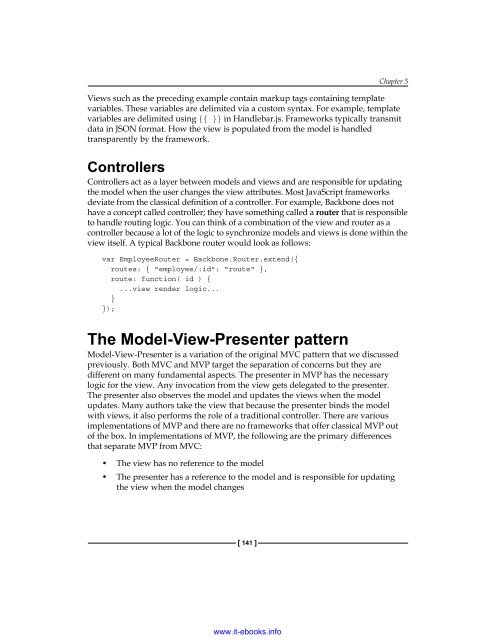Create successful ePaper yourself
Turn your PDF publications into a flip-book with our unique Google optimized e-Paper software.
Chapter 5<br />
Views such as the preceding example contain markup tags containing template<br />
variables. These variables are delimited via a custom syntax. For example, template<br />
variables are delimited using {{ }} in Handlebar.js. Frameworks typically transmit<br />
data in JSON format. How the view is populated from the model is handled<br />
transparently by the framework.<br />
Controllers<br />
Controllers act as a layer between models and views and are responsible for updating<br />
the model when the user changes the view attributes. Most <strong>JavaScript</strong> frameworks<br />
deviate from the classical definition of a controller. For example, Backbone does not<br />
have a concept called controller; they have something called a router that is responsible<br />
to handle routing logic. You can think of a combination of the view and router as a<br />
controller because a lot of the logic to synchronize models and views is done within the<br />
view itself. A typical Backbone router would look as follows:<br />
var EmployeeRouter = Backbone.Router.extend({<br />
routes: { "employee/:id": "route" },<br />
route: function( id ) {<br />
...view render logic...<br />
}<br />
});<br />
The Model-View-Presenter pattern<br />
Model-View-Presenter is a variation of the original MVC pattern that we discussed<br />
previously. Both MVC and MVP target the separation of concerns but they are<br />
different on many fundamental aspects. The presenter in MVP has the necessary<br />
logic for the view. Any invocation from the view gets delegated to the presenter.<br />
The presenter also observes the model and updates the views when the model<br />
updates. Many authors take the view that because the presenter binds the model<br />
with views, it also performs the role of a traditional controller. There are various<br />
implementations of MVP and there are no frameworks that offer classical MVP out<br />
of the box. In implementations of MVP, the following are the primary differences<br />
that separate MVP from MVC:<br />
• The view has no reference to the model<br />
• The presenter has a reference to the model and is responsible for updating<br />
the view when the model changes<br />
[ 141 ]<br />
www.it-ebooks.info


